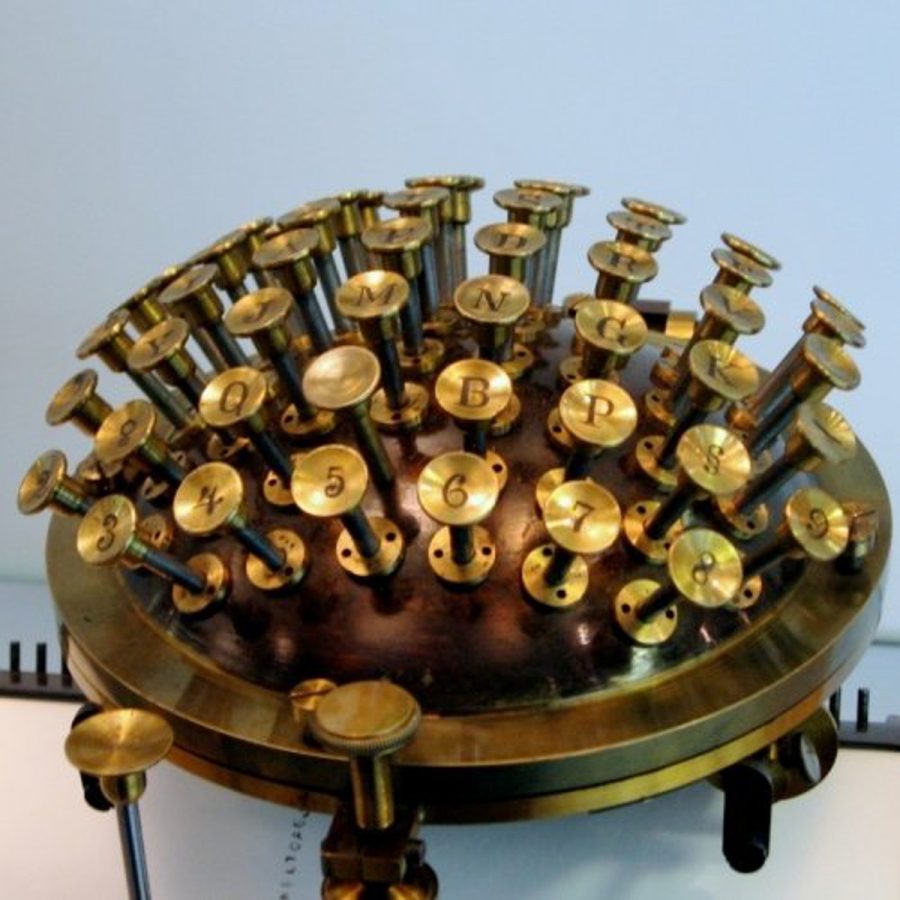
During his final decade, Friedrich Nietzsche’s worsening constitution continued to plague the philosopher. In addition to having suffered from incapacitating indigestion, insomnia, and migraines for much of his life, the 1880s brought about a dramatic deterioration in Nietzsche’s eyesight, with a doctor noting that his “right eye could only perceive mistaken and distorted images.”
Nietzsche himself declared that writing and reading for more than twenty minutes had grown excessively painful. With his intellectual output reaching its peak during this period, Nietzsche required a device that would let him write while making minimal demands on his vision.
So he sought to buy a typewriter in 1881. Although he was aware of Remington typewriters, the ailing philosopher looked for a model that would be fairly portable, allowing him to travel, when necessary, to more salubrious climates. The Malling-Hansen Writing Ball seemed to fit the bill:
In Dieter Eberwein’s free Nietzches Screibkugel e‑book (an English outline is available here), the vice president of the Malling-Hansen Society explains that the writing ball was the closest thing to a 19th century laptop. The first commercially-produced typewriter, the writing ball was the 1865 creation of Danish inventor Rasmus Malling-Hansen, and was shown at the 1878 Paris Universal Exhibition to journalistic acclaim:
“In the year 1875, a quick writing apparatus, designed by Mr. L. Sholes in America, and manufactured by Mr. Remington, was introduced in London. This machine was superior to the Malling-Hansen writing apparatus; but the writing ball in its present form far excels the Remington machine. It secures greater rapidity, and its writing is clearer and more precise than that of the American instrument. The Danish apparatus has more keys, is much less complicated, built with greater precision, more solid, and much smaller and lighter than the Remington, and moreover, is cheaper.”
Despite his initial excitement, Nietzsche quickly grew tired of the intricate contraption. According to Eberwein, the philosopher struggled with the device after it was damaged during a trip to Genoa; an inept mechanic trying to make the necessary repairs may have broken the writing ball even further. Still, Nietzsche typed some 60 manuscripts on his writing ball, including what may be the most poignant poetic treatment of typewriters to date:
“THE WRITING BALL IS A THING LIKE ME:
MADE OF IRON YET EASILY TWISTED ON JOURNEYS.
PATIENCE AND TACT ARE REQUIRED IN ABUNDANCE
AS WELL AS FINE FINGERS TO USE US.”
In addition to viewing several of Nietzsche’s original typescripts at the Malling-Hansen Society website, those wanting a closer look at Nietzsche’s model can view it in the video above. Felix Herbst, the video’s creator, has kindly provided a functional writing ball simulator on his website. I’d encourage you to give typing a shot—there’s something oddly satisfying about the crisp imprints made by its clattering metallic keys.
via The Malling-Hansen Society
Ilia Blinderman is a Montreal-based culture and science writer. Follow him at @iliablinderman.
Related Content:
Mark Twain Wrote the First Book Ever Written With a Typewriter
Woody Allen’s Typewriter, Scissors and Stapler: The Great Filmmaker Shows Us How He Writes
Walter Kaufmann’s Classic Lectures on Nietzsche, Kierkegaard and Sartre (1960)
The Philosophy of Nietzsche: An Introduction by Alain de Botton
Download 90 Free Philosophy Courses and Start Living the Examined Life


Screibkugel, not ‑kigel.
What? You don’t like kugel? Also, if you’re going to be so particular, it’s schreib, not screib.……
OK. How about Nietzsches rather than Nietzches in the title?
And, for those so minded, you can even get a free font imitating the type face it used courtesy of the Cape Arcona Type Foundary. Hours of fun for all … maybe.
Thanks for the article.
http://www.cape-arcona.com/typefaces/nihilsuperstar/